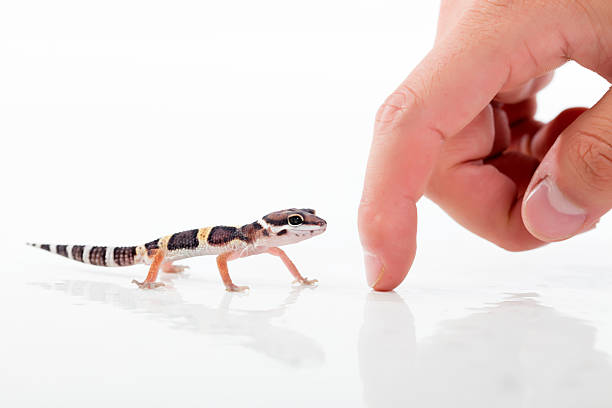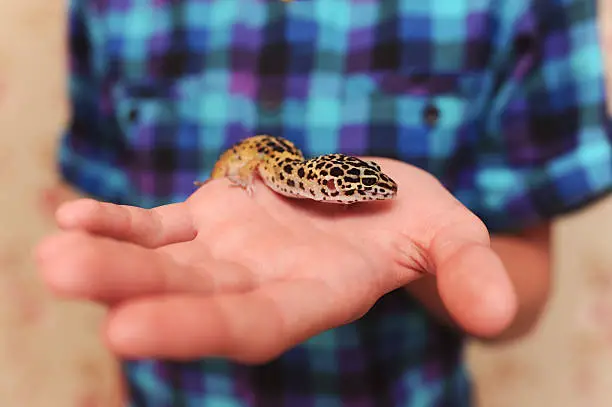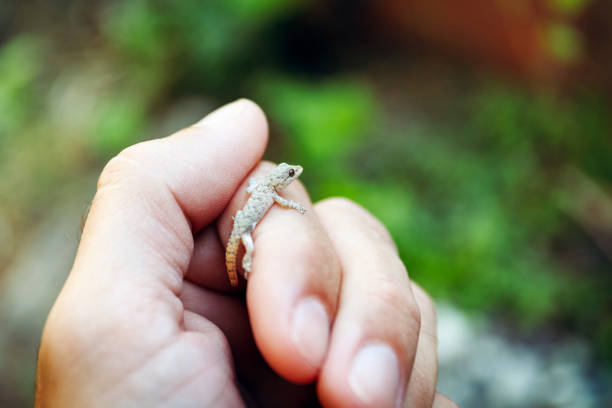If handled properly, leopard geckos enjoy being played with. However, many novice owners get a hard time interpreting their behaviors when trying to pet them. Some of the top questions about Leopard Gecko petting range from concerns on their age, how close to get to them, and even whether they are ill. This article will explore most of these questions to help you determine if geckos like to be touched.
Leopard geckos are small lizards with short tails. The species can reach lengths of 20 cm and up to 80 grams. As they are small, they are often kept as pets, as they are considered a good starter reptile for beginners. Leopard geckos are relatively easy to pet and are very friendly. They require a quiet, cool environment and are not suitable for households with young children or those who have cats.
With this background, most beginner pet owners find it challenging to know if the geckos like to be touched or loved from a distance.
In this article
How to tell if your Leopard Gecko is scared of you.
Leopard geckos require a lot of attention, especially when they are babies. They need time to get used to you and their new environment. It can take around 3-6 weeks for them to get used to you and their new home. Sometimes, it can take longer, so you need to be patient. You will need to make sure they are not stressed. Otherwise, you won’t have as much fun with them.
Below are some of the signs that a gecko is scared of you;
- The leopard gecko is always running from you when you approach their tank.
- Being aggressive when you want to deal with it.
- The leopard gecko is less active.
- The leopard gecko is consuming less food.
- For a long period, hiding in a hideout.
- It does not allow you to handle it.
- Leopard gecko will raise and wag its tail.
How to easily bond with a leopard gecko.
Leopard geckos need just enough time to acclimatize, get comfortable and get used to you. It can take anywhere from 3 weeks to 3 months or even six months.

Building trust is what bonding with your leopard gecko is about. It is important for your gecko to feel safe. It will learn to enjoy your company once it is used to its environment and understands that this human hand is not a threat.
Below are practical tips that will help enhance and shorten the initial bonding period;
- After bringing your leopard gecko home, allow 2-3 weeks before trying to play with him.
- If you want the leopard gecko to be comfortable, you should give it some food. Handling and feeding time will become associated with each other.
- Put your hand in their tank and let them explore without trying to catch them. Leave your hand there and let the geckos get used to you as not a threat.
- Speak softly to your leopard gecko, and be calm.
- Keep your voice consistent when announcing your presence. Never pull surprise visits.
- Before you handle it, make sure your hands are always warm.
- If you want to carry your gecko up, don’t try to grab it when it is running. Let it go free and try again later. If it is scared enough, it may decide to drop its tail.
- Hand feed your leopard gecko once or twice a week but always check on their tank.
- Make sure that the room you’re going to take your gecko out of the enclosure is well-ventilated and has no other animals in it.
How Leopard Gecko likes to be touched and held.
To lift a gecko, gently grasp its body with your hand, palm up. Position your fingers pointing towards the gecko and gently cup its body in your hand. Slowly lift and gently support the gecko’s full body weight. It is important to practice this when your gecko has gotten used to your hand and sits on it willingly.

To bond with your gecko, let it climb onto your hand. Because leopard geckos like to be touched, this will help you get to know each other better. Your leopard gecko can get used to the feel of your hands and eventually trust you, so it can learn to stay on your hand. Your leopard gecko may learn to trust you by sitting on the floor and holding your hands a few inches above the surface. This way, if your leopard gecko falls, you want to minimize the distance it would fall to the floor.
Don’t grab your leopard gecko by the tail. The leopard gecko’s tail can be dropped when under threat to help it avoid danger. A regrown tail is usually not the same as the original one and will take longer to grow. I am sure you don’t want this.
Besides the actual physical handling, you must also ensure that the environment and handling time are just right. A good setting and timing will minimize stressing your gecko and offer both of you a better experience. These factors include:
Start Handling your geckos when young.

It is recommended to purchase your leopard gecko when it is young. As much as a young gecko will pose a handling challenge due to its fragile nature, you will better understand its history and even easily bond. As the gecko matures, it will be more calm and easy to handle.
Avoid Bright Lighting.
During the day, leopard geckos hide from the bright light and sleep. In the evening, they emerge to start their day. It is best to schedule your petting times to evening hours when they are naturally awake. Most of us wouldn’t enjoy being prodded awake at 2 AM, and your gecko doesn’t like its natural sleep cycle disturbed either.
It is thus not recommended to have bright lights in its tank. Opt to use a heated pad instead of any other heater that emits too much light. Leopard geckos living in bright, high-UVB environments will have their vision affected and won’t be comfortable to be held.
Avoid Handling during Shedding.
A few days before and after shedding, your leopard gecko might not eat as usual. Some leopard geckos will be uninterested in any contact during the shedding days. Don’t try to pick them up or touch them.
Keep their environment quiet.
Remember, your Leopard gecko will always expect you to announce your presence with a consistent and recognizable voice. Advertising your presence will ensure your pet is not startled or feel like it is in danger as you approach to start running away. To achieve this, ensure there are no competing/confusing sounds or noise in their habitat. These include TVs, radio and any noisy location.
Play for Just enough time.
It is important not to take the gecko out of their tank for too long, especially in the surrounding in not well heated. This is because they rely on heat to be active and healthy. If your gecko’s belly gets cold to the touch, you may want to place it back in its tank to warm up. Geckos can lose their energy quickly when they are cold.
Conclusion.
So, do leopard geckos like to be touched? Yes, geckos like to be touched but they must first be comfortable in their environment and around the person handling them.
Ensure you consider the above-shared factors to enhance your leopard gecko petting experience.

